Exorcists Take Warning: DAW’s The Year’s Best Horror Stories II (1974), edited by Richard Davis
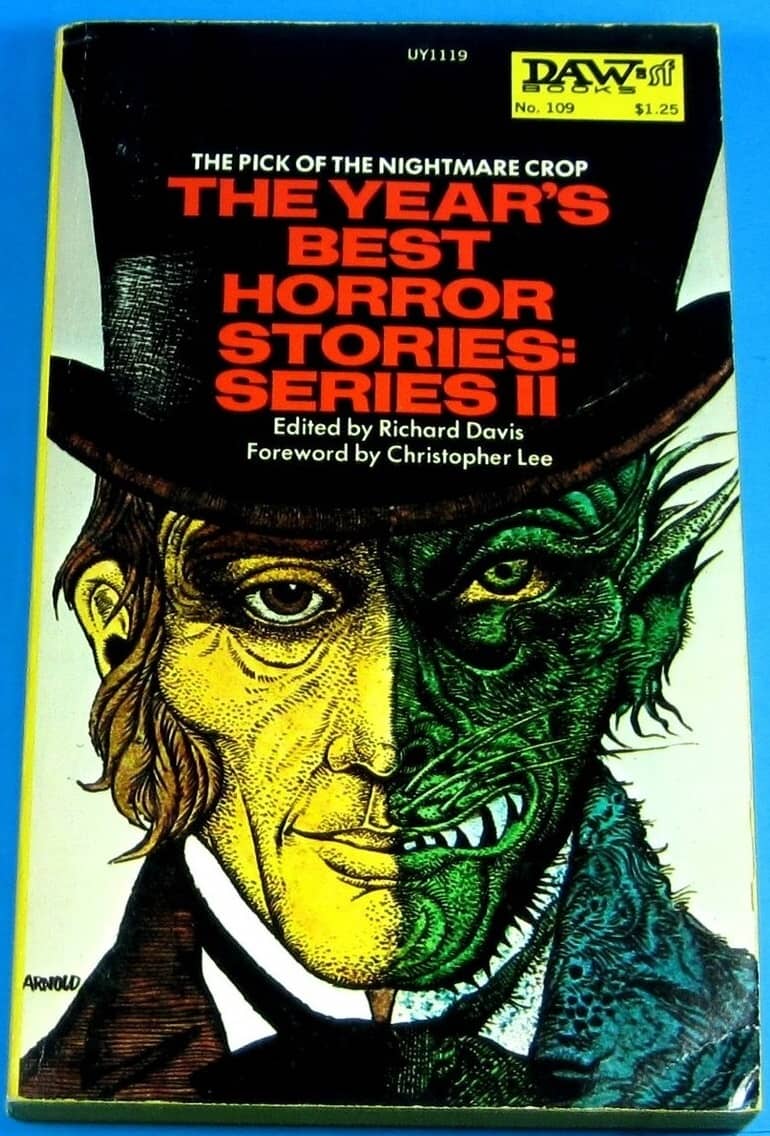 |
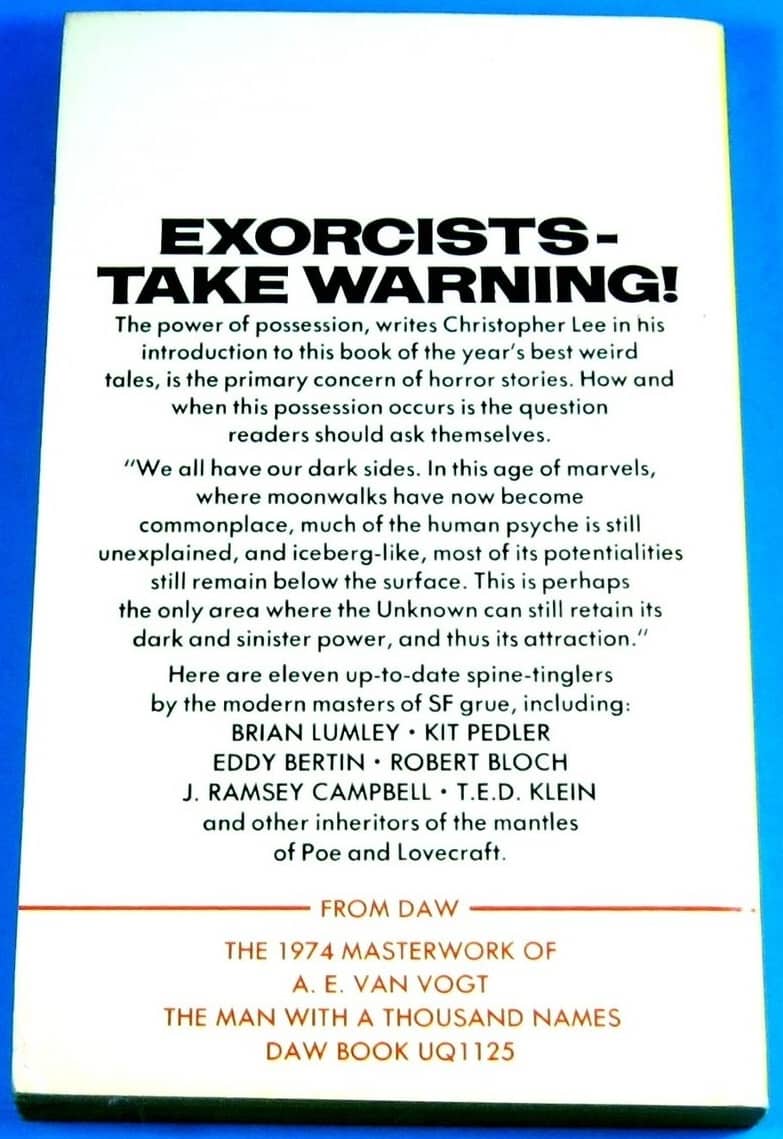 |
The Year’s Best Horror Stories Series II (DAW, July 1974). Cover by Hans Arnold
The Year’s Best Horror Stories: Series II was the second volume in DAW’s Year’s Best Horror Stories. Copyright 1972, 1973, but printed in 1974. Like the first, it was edited by Richard Davis. The cover, by Swiss artist Hans Arnold (1925–2010), was much more in line with a horror themed anthology than the first one. Clearly the cover is an homage to Dr. Jekyll and Mr. Hyde, though there’s no story with a similar theme found within.
It had been two years since the release of DAW’s first The Year’s Best Horror Stories, which had been adopted — story for story — from Davis’ first British Sphere edition with same name. But for DAW’s The Year’s Best Horror Stories: Series II, Davis did more than simply bring over every tale from the second Sphere volume. Some stories were dropped, and some added. Comparing the tables of contents, both volumes contain the Foreword by actor Christopher Lee, “David’s Worm” by Brian Lumley, “The Price of the Demon” by Gary Brandner, “The Knocker at the Portico” by Basil Copper, “The Animal Fair” by Robert Bloch, “Napier Court” by Ramsey Campbell, and “Haunts of the Very Rich” by T. K. Brown, III.
But the Sphere volume also had a Preface by Richard Davis, plus
“Thirst” by Gerald W. Page (who would go on to edit DAW volumes 4–7)
“The Throwaway Man” by Stephan Chapman
“The Woman with the Mauve Face” by Rosemary Timperley, and
“The Shadows of the Living” by Ronald Blythe
In place of those, Davis added
“The Long-Term Residents” by Kit Pedler
“Like Two White Spiders” by Eddy C. Bertin
“The Old Horns” by Ramsey Campbell,
“Haggopian” by Brian Lumley,
and the amazing “The Events at Poroth Farm” by T. E. D. Klein
Why did Davis make these changes from the British Sphere edition? I think the answer is primarily that Davis’ third Sphere volume, The Year’s Best Horror Stories No. 3 had already been published. Perusing the table of contents, it seems that Davis sought to bring in what he saw as the best from that volume as well.
Thus, DAW’s The Year’s Best Horror Stories: Series II seems to be an amalgamation of the second and third Sphere volumes that Davis had already edited. However, the amalgamation also made the DAW edition a bit unbalanced, since it now had two Lumley stories and two Campbell stories.
That IS a creepy cover!
Five of the stories in The Year’s Best Horror Stories: Series II were originally sourced from books, three from magazines, and three were first published in fanzines. Six authors were British, four were American, and Eddy Bertin is our lone Belgian again. The volume contains only male authors this time. Obviously, representation was not a driving concern in the early 70s.
I think that DAW had learned a thing or two since their first The Year’s Best Horror Stories. The cover art is better, and they even included a page of inner artwork, a creepy frontispiece by the American artist Jack Gaughan (1930–1985). The quality of these ink pics in DAW books was usually fairly poor, but I think this one is pretty good and particularly effective.
The inclusion of actor Christopher Lee (1922–2015), who did the forward, was a nice touch on Davis’ part. By 1973 Lee was most famous for his Hammer horror films. And that same year he would go on to play the cult leader in The Wicker Man. We would later associate him big box office roles like Saruman in The Lord of the Ring, or Count Dooku in the Star Wars, but at this point Lee was clearly Mr. Horror. And his foreword is more than a puff piece; it was an informed and interesting essay.
I loved The Year’s Best Horror Stories, but The Year’s Best Horror Stories: Series II was even stronger. The lead tale, Lumley’s “David’s Worm,” is about a boy who swipes a microscopic worm from his father-biologist’s lab and slowly nurtures it in a nearby pond. The worm is a type that takes on certain characteristics of whatever it eats. Oh, and the worm has been exposed to radiation. Can’t forget that interesting detail. I think you can see some of the horrific directions this may go; it was a truly gruesome tale, all the way to the italicized last line!
Lumley’s other story, “Happogian,” is one of his typical Lovecraftian homages. Though I usually find these not very scary, this one was a bit more chilling than his stories in this vein usually are.
“The Price of a Demon” by Gary Brandner was a little more traditional, a supernatural tale of a demon that is mistakenly summoned and cannot be un-summoned. The modern twist is that it’s a 1970s “housewife,” usually busy with yoga and new age wiccan classes, who finds an old book of spells in a used bookstore. It’s a bit predictable, but effectively scary. I had never heard of Brandner, but he evidently wrote quite a bit. He would later become most well-known for his 1977 novel The Howling, which of course started the werewolf movie franchise.
The Howling (Fawcett Gold Medal)
Basil Copper’s “The Knocker at the Portico” was a psychological horror/ghost story. Like Ramsey Campbell, I tend to have a hard time following his British-isms. But Copper’s tale has a good buildup and a surprising ending.
I did not find Campbell’s “The Old Horns” very scary but his “Napier Court” was a very effective blend of psychological horror and ghost story. I’m beginning to see the ambiguously psychological/ghost story as a bit of a trend, including a few stories from the first The Year’s Best Horror Stories. But the idea of course is not new. It goes back to classics such as Henry James’ The Turn of the Screw and of course any number of Edgar Allan Poe stories.
I also didn’t find Eddy C. Bertin’s “Like Two White Spiders” very scary either, a tale of a man’s demon-possessed hands. I thought his story in the first volume much better.
“The Long-Term Residents” by Kit Pedler was also very good. It’s a very slow-burn, slow-buildup piece. There is a constant undercurrent of dread throughout and the ending was somewhat surprising. It reminded me a bit of Dennis Etchison or Robert Aikman in style.
Haunts of the Very Rich (ABC Circle Films, 1972)
My second favorite tale in The Year’s Best Horror Stories: Series II was “Haunts of the Very Rich” by T. K. Brown, III, whom I had never heard of. It focuses on a group of incredibly wealthy people who have signed up for an exclusive get-away to an undisclosed location. They are taken by private plane with the windows completely blacked out. When they arrive, they seem to be in a tropical paradise at a resort that has all the amenities and pleasures one could imagine. But soon things begin to go wrong. First, the power goes out, which of course becomes very uncomfortable in a tropical resort — no air conditioning. But surely, at a ritzy resort, they’ll be able to get the power up and going again. But it does not come on again –– ever.
Slowly things get worse. First the luxuries, and then the necessities, begin to run out. The wealthy guests really begin to despair when food and water runs low and they have no means of contacting the outside world. But then a single-manned plane shows up to let them know help is on the way – until the guests remember that the pilot was someone that they heard had died several days earlier. This becomes a regular occurrence. Every time that it seems that help is imminent, their hopes are dashed and the situation becomes more and more dire. Finally, one of the characters realizes, (spoiler) that all the rich guests, all of the main characters, are actually dead:
It was the Dugans that gave me the final clue, when they couldn’t remember getting on the plane. All of us have a blank space in our lives, just before the trip. (p. 89)
I really liked this story. It felt like a horror-story version of the TV show Lost. Though the characters were pretty miserable people, you couldn’t help sympathizing with them and feeling pity when each small hope was taken from them, one after another.
I found a 1972 made-for-television movie of this story on YouTube (starring Lloyd Bridges and Ed Asner), which adhered to the story fairly closely. I was disappointed to find that T. K. Brown didn’t really write much other than this story. Pity.
The Ceremonies (PS Publishing reprint, 2016). Cover by Anne Sudworth
In my opinion though, T. E. D. Klein’s “The Events at Poroth Farm” was clearly the best story in The Year’s Best Horror Stories: Series II. I am a huge Klein fan. I’ve read this story many, many times and so it’s no surprise to me that it made this anthology. “The Events at Poroth Farm” was later published in Gahan Wilson’s First World Fantasy Awards (1977) and has been anthologized many times. Klein eventually expanded the story into the 1984 novel Ceremonies.
Besides the Sphere volume, this would have been the first professional appearance of Klein’s story, and its first publication in America. It’s probably the reason this DAW volume is one of the hardest and most expensive volumes of Year’s Best Horror Stories to track down.
Black Gate’s own Stephen Silver summarizes “The Events at Poroth Farm” perfectly:
“The Events at Poroth Farm” is a Lovecraftian tale told as a series of diary entries bookended by a prologue and epilogue by the diary’s author, who has managed to survive the horror on the isolated farm where he rented a room for three months.
The prologue is overwritten as is much Lovecraftian style fiction and descriptive of the community in which the narrator has found himself, a secluded place to read Gothic novels in preparation for teaching a class on it in the Fall. His entries detail his growing relationship with his landlords, Sarr and Deborah Porath, as well as their clowder of cats.
The horror begins when the narrator finds one of the cats dead, a hole in its side apparently made from inside the cat. Before he can tell his hosts about their cat, the creature shows up, alive, and begins a reign of terror, not only of the other cats and chickens, but eventually of the humans living on Poroth Farm.
In sum, Richard Davis’s selections continued to show in The Year’s Best Horror Stories: Series II that, though most of these writers were clearly influenced and honoring the horror writers that came before, they were also seeking to bring it into the Twentieth Century. In 1974, the state of horror short fiction looked strong and promising.
20 of the 22 volumes of The Year’s Best Horror Stories (DAW Books)
Here’s the complete Table of Contents for The Year’s Best Horror Stories: Series II:
Foreword by Christopher LeeThe Year’s Best Horror Stories: Series II was published by DAW Books in July 1974. It is 207 pages, priced at $1.25. The cover is by Hans Arnold.
“David’s Worm” by Brian Lumley (Pulp, 1971)
“The Price of a Demon” by Gary Brandner (Witchcraft and Sorcery, 1972)
“The Knocker at the Portico” by Basil Copper (Dark Things, 1971)
“The Animal Fair” by Robert Bloch (Playboy, 1971)
“Napier Court” by J. Ramsey Campbell (Dark Things, 1971)
“Haunts of the Very Rich” by T. K. Brown, III (Playboy, 1971)
“The Long-Term Residents” by Kit Pedler (The Seventh Ghost Book, 1971)
“Like Two White Spiders” by Eddy C. Bertin (De Achtjaarlijkse God, 1971)
“The Old Horns” by J. Ramsey Campbell (Demons by Daylight, 1973)
“Haggopian” by Brian Lumley (Fantasy and Science Fiction, 1973)
“The Events at Poroth Farm” by T. E. D. Klein (It was wrongly attributed to Nyctalops, 1972. It actually first appeared in Beyond the Dark Gateway #2, 1972, a very, very difficult fanzine to find!)
Previous installments in this series include:
Introduction To DAW Books’ The Year’s Best Horror Stories (1972–1994)
The Year’s Best Horror Stories: Series I (1972)
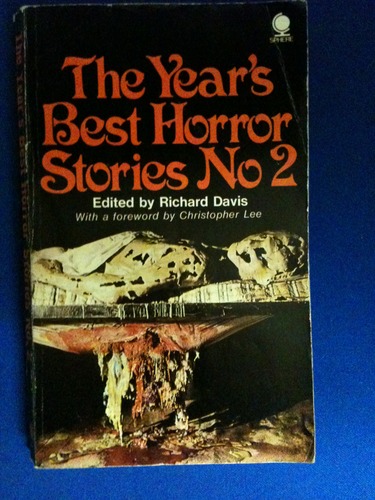
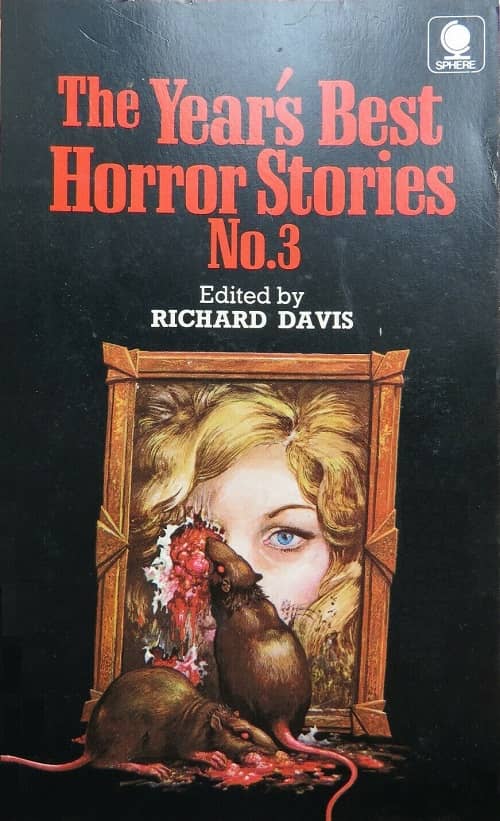
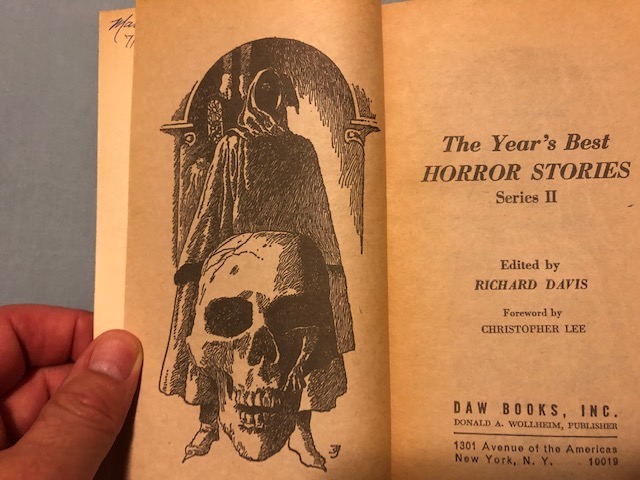
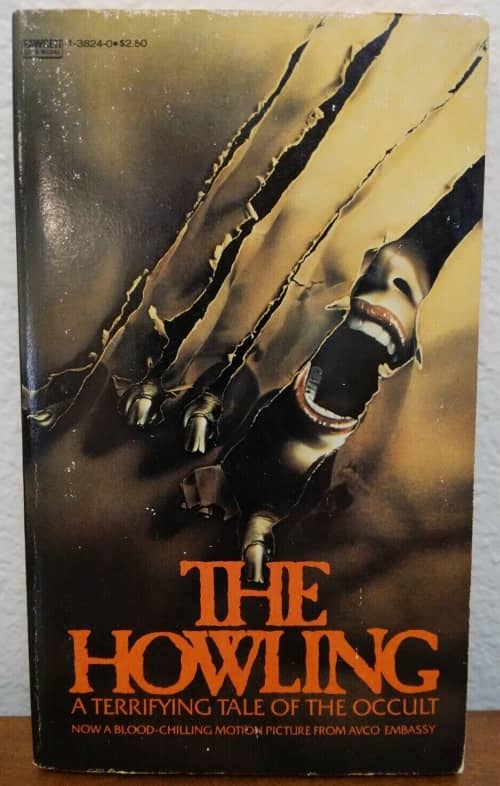
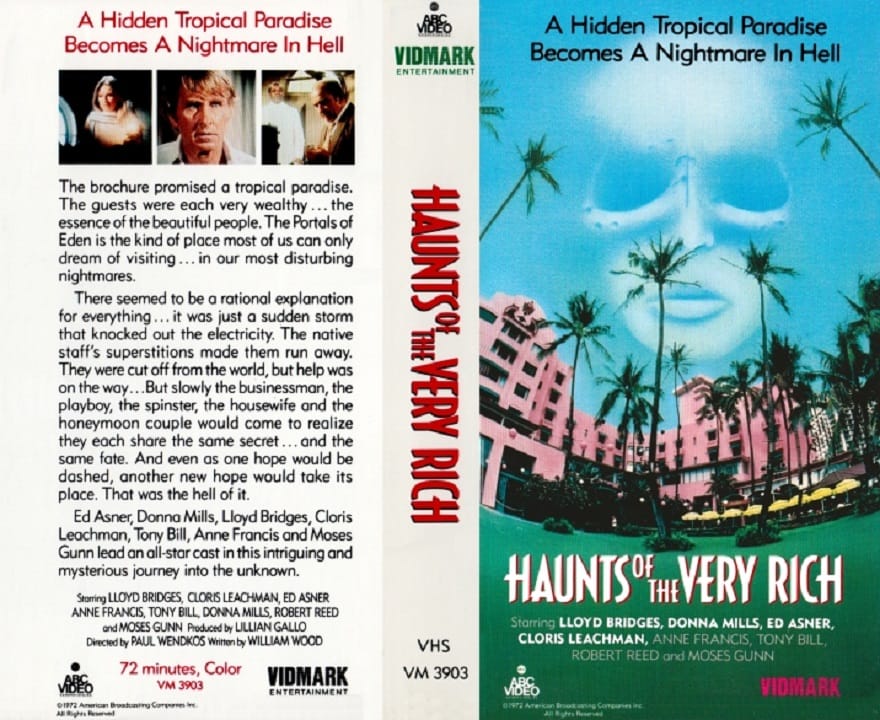
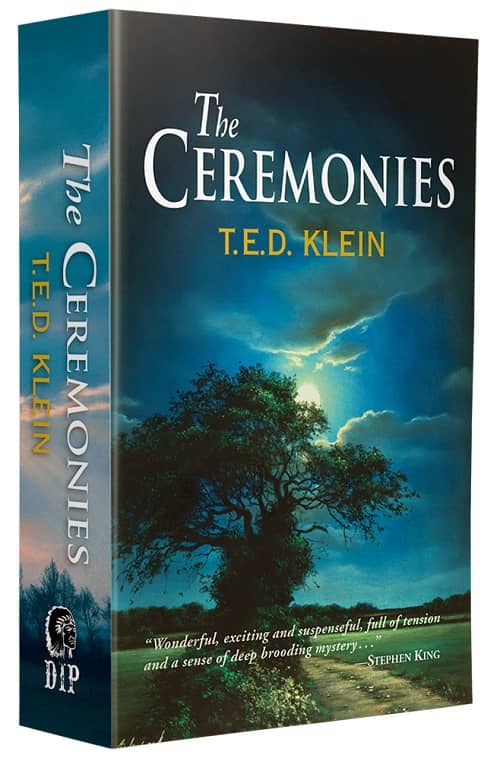
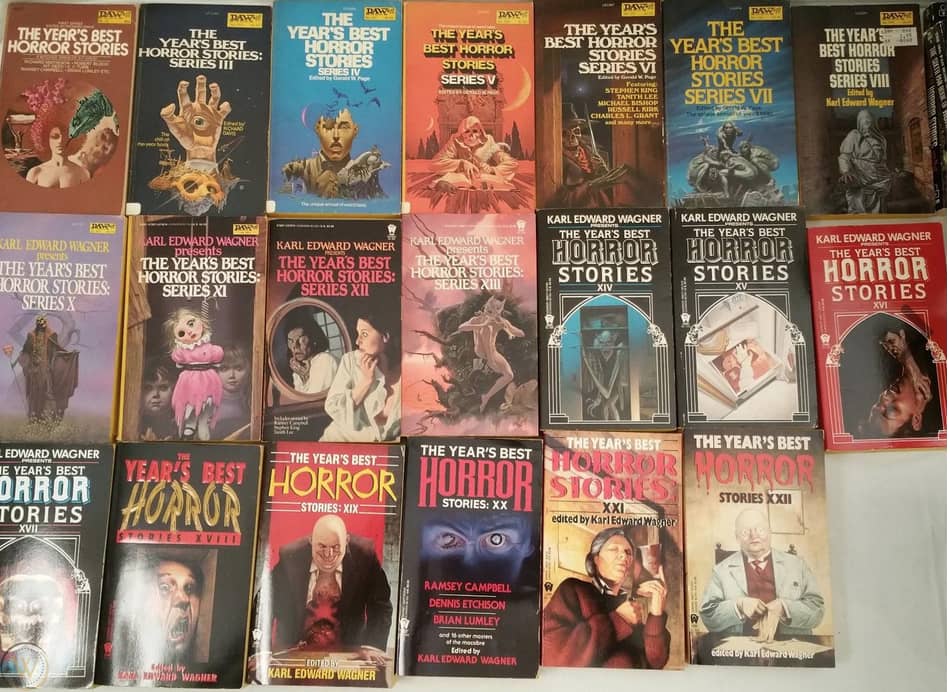
The Haunts of the Very Rich ABC Movie of the Week was one of my favorites back in the day; I have a bootleg DVD of it that I still pop in occasionally for a nostalgia fix. I had no idea it was originally a short story. Now I MUST read it – off to Ebay!
Ah, those good old times!
WITCHCRAFT AND SORCERY, edited by Gerald W. Page, wasn’t a fanzine…more a “little” or semi-pro magazine, with some newsstand distribution.
Interesting misdirect on my blog address to a religious site.
Thanks for the clarification. Curious though, what exactly is the difference?
Fanzines are usually exclusively labors of love, while little magazines and semi-pro markets do pay, if almost never handsomely. Fanzine fiction which isn’t fiction about fans does tend to run a bit worse.
Drat. I’ve gotten snowed under and haven’t had a chance to read this book or even keep up with Black Gate this past week. I guess I know what I’ll be reading this weekend.
It’s worth it. The second volume is stronger than the first, which was still good. I think the next couple volumes are ok though. Volumes 5 or 6 pick it back up though.
Appreciate you parsing the distinctions between the US and UK volumes! I’ve tried doing that and my eyes just glaze over. Well done! Also, I’ve never seen that cover with the rats eating the woman’s portrait–nice find.